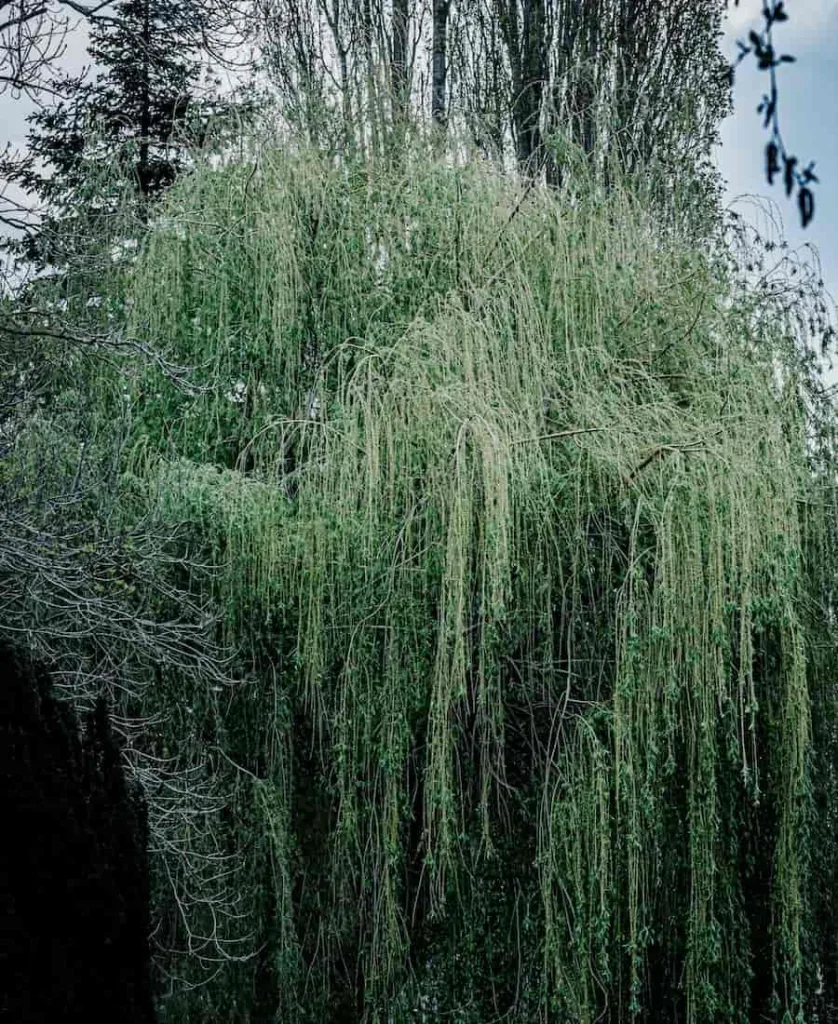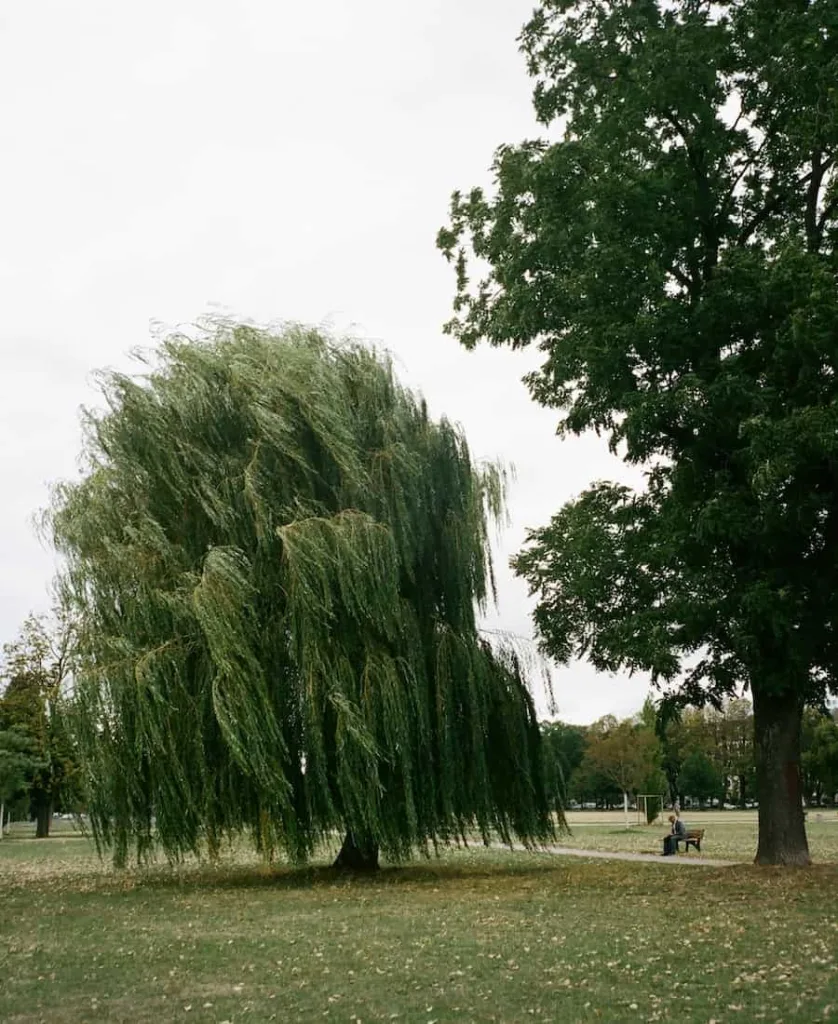The willow tree has long been a symbol of strength, resilience, and flexibility.
It has been revered in many cultures for its spiritual significance and is often associated with healing, intuition, and emotional experiences.
The tree’s long, flowing branches and delicate leaves have inspired artists, poets, and writers for centuries, and its symbolism has been explored in various religious and spiritual traditions.
In the Bible, the willow tree is mentioned several times, with Psalm 137 stating, “There on the willow trees, we hung up our harps.”
The tree is also associated with the Jewish holiday of Sukkot, during which willow branches are used in the construction of temporary shelters.
In Celtic mythology, the willow tree is linked to the moon and is seen as a symbol of the feminine, with its branches representing the lunar cycles and the tree’s ability to regenerate from cuttings representing the power of rebirth.
The spiritual meaning of the willow tree varies depending on the culture and belief system, but it is generally associated with growth, adaptability, and the ability to weather difficult times.
Whether used in meditation, ritual, or simply as a symbol of hope and resilience, the willow tree continues to inspire and uplift people around the world.
Historical Significance of Willow Trees

Willow trees have been a part of human history for centuries and have played significant roles in various cultures and traditions. Here are some examples of the historical significance of willow trees:
Chinese Culture
In Chinese culture, the willow tree is known as the “gentleman of trees” and is a symbol of elegance, grace, and flexibility.
The Chinese have used willow bark for medicinal purposes for thousands of years. The bark contains salicylic acid, which is similar to aspirin and has pain-relieving properties.
Celtic Culture
In Celtic symbolism, willow trees represent nature’s balance. The green leaves of willow trees are believed to symbolize nature and balance.
The Celts also believed that willow trees had healing properties and that they could help cure illnesses.
European Culture
In European culture, willow trees were often associated with death and mourning. Willow branches were used to make wreaths for funerals, and the tree itself was often planted in cemeteries.
Greek Mythology
In Greek mythology, the goddess Persephone was abducted by Hades and taken to the underworld.
While in the underworld, she was comforted by the shade of a willow tree. The willow tree became a symbol of grief and mourning.
Japanese Culture
In Japanese culture, the willow tree is known as “yanagi” and is a symbol of resilience, flexibility, and adaptability.
The Japanese have used willow bark for medicinal purposes for centuries. The bark contains a compound called salicin, which is similar to aspirin and has pain-relieving properties.
Native American Culture
Native Americans have a strong connection to nature, and willow trees were often used for medicinal purposes.
The bark was used to treat headaches, fever, and pain, and the leaves were used to make a tea that could help relieve menstrual cramps.
Overall, willow trees have played significant roles in various cultures and traditions throughout history. From medicine to mythology, the willow tree has been a symbol of resilience, flexibility, and adaptability.
Spiritual Symbolism of Willow Trees
Willow trees have been associated with spirituality and symbolism in various cultures around the world.
The spiritual meaning of a willow tree is symbolic of resilience, flexibility, and harmony with nature.
In Celtic Symbolism, willow trees represent nature’s balance. The green leaves of willow trees are believed to symbolize nature and balance.
Everything in nature, including air, trees, creatures, etc., stays in balance and goes on with life..
The willow tree’s long-held symbolism of rebirth and vitality is referenced in Ezekiel 17:5. The prophet plants a seed and “sets it like a willow tree.”
This makes reference to the willow tree’s ability to regenerate and grow even after it has been cut down.
Overall, the spiritual symbolism of willow trees is rooted in their connection with nature and their ability to adapt and persevere through difficult times.
The Willow Tree in Mythology
The willow tree has been a significant symbol in various mythologies and cultures around the world.
In Greek mythology, the willow tree was associated with the goddess Hera, who was the queen of the gods.
According to the myth, Hera turned her rival into a willow tree, which is why the willow is also known as the tree of grief and mourning.
In Celtic mythology, the willow tree was associated with the goddess Brigid, who was the goddess of poetry, healing, and smithcraft.
The willow tree was also associated with the moon and water, which are both symbols of the feminine.
The Celts believed that the willow tree had the power to heal and protect, and it was often used in rituals and ceremonies.
Native Americans also had a deep reverence for the willow tree. They believed that the willow tree had the power to connect them to the spirit world and the ancestors.
The willow tree was also associated with dreams and visions, and it was believed that sleeping under a willow tree would bring prophetic dreams.
In Chinese culture, the willow tree was associated with the moon and was often depicted in paintings alongside a full moon.
The tree was also associated with the goddess of mercy, Kuan Yin, who is often shown holding a willow branch.
The Chinese believed that the willow tree had the power to ward off evil spirits and protect against illness.
In Norse mythology, the willow tree was associated with the elves, who were the guardians of the natural world.
The willow tree was believed to be a gateway to the otherworld, and it was often used in rituals to connect with the spirits of nature.
Overall, the willow tree has been a significant symbol in many mythologies and cultures around the world.
Emotional and Healing Power of Willow Trees
Willow trees are widely known for their emotional and healing power. They have been used for centuries to help people cope with pain, grief, mourning, and loss.
The tree’s symbolism of resilience, flexibility, and harmony with nature is what makes it a powerful tool for emotional healing.
The emotional power of willow trees lies in their ability to provide a sense of comfort and security.
The tree’s branches and leaves create a canopy that can shield people from harsh weather conditions, just like how it can provide a sense of protection from emotional turmoil.
In terms of healing power, the willow tree has been used for its pain-relieving properties. Its bark contains salicin, which is a natural pain reliever that is similar to aspirin.
The bark can be boiled and used to create a tea that can help alleviate pain and reduce inflammation.
Moreover, the willow tree’s association with water makes it a powerful symbol for emotional healing. Water is a symbol of purification and renewal, and the willow tree’s proximity to water can help facilitate emotional healing.
The tree’s roots can absorb negative energy, and its leaves can help purify the air, creating a space that is conducive to emotional healing.
In conclusion, the emotional and healing power of willow trees is undeniable.
Recommended post: Black moth meaning (11 spiritual meanings).
Willow Tree and Nature’s Elements

Willow trees have a deep connection with nature’s elements, making them powerful symbols of healing, intuition, and emotional experiences. Here are some of the ways in which willow trees are linked to nature:
Water
Willow trees are often found near water sources such as rivers, lakes, and ponds. This is because they have a deep connection with water and are often referred to as “water-loving” trees.
The willow tree’s roots are known to grow deep into the ground, allowing them to draw water from deep within the earth.
This makes them resilient to droughts and other harsh weather conditions. The tree’s association with water also makes it a symbol of purification, cleansing, and renewal.
Moon
The willow tree has a special connection with the moon. In many cultures, the willow tree is associated with the lunar cycle and the phases of the moon.
This is because the tree’s branches and leaves sway gracefully in the moonlight, creating a mystical and enchanting atmosphere.
Branches and Leaves
The willow tree’s branches and leaves are known for their flexibility and resilience. They are able to bend and sway with the wind, making them a symbol of adaptability and survival.
The tree’s branches and leaves are also used in traditional medicine to treat a variety of ailments, including headaches, fever, and inflammation.
Trees
Willow trees are part of the Salix family, which includes over 400 species of trees and shrubs. They are found in many parts of the world, including Europe, Asia, and North America.
The tree’s long and slender branches make it a popular choice for basket weaving and other crafts. The tree’s wood is also used to make furniture, tools, and other household items.
In conclusion, the willow tree’s connection to nature’s elements makes it a powerful symbol of healing, intuition, and emotional experiences.
Willow Tree in Literature and Arts
The willow tree has been a source of inspiration for artists and writers for centuries.
Its graceful, weeping branches and delicate leaves have been featured in literature, music, and art in various cultures around the world.
In literature, the willow tree is often associated with sadness, grief, and mourning. In Shakespeare’s play “Hamlet,” Ophelia sings a song about a willow tree after her father’s death.
The song is a lament for her lost love and her own impending death. The willow tree is also mentioned in J.K. Rowling’s “Harry Potter” series, where it is used as a symbol of mourning and remembrance.
Musicians have also been inspired by the willow tree. The folk song “The Willow Tree” tells the story of a young man who falls in love with a woman who is already promised to another.
The willow tree is used as a symbol of the young man’s unrequited love and his sorrow at the loss of his beloved.
In art, the willow tree has been depicted in many different ways. The Chinese artist Wu Guanzhong painted a series of willow tree landscapes, using bold brushstrokes and bright colors to capture the tree’s beauty and grace.
The French artist Claude Monet also painted a series of willow tree landscapes, using the tree’s weeping branches to create a sense of movement and flow in his paintings.
Overall, the willow tree’s symbolism and beauty have made it a popular subject in literature, music, and art throughout history.
Recommended post: 11 Spiritual meanings of a white butterfly landing on you.
Physical Attributes and Their Meanings
The willow tree is known for its distinctive physical attributes, which hold significant meanings in various cultures.
Here are some of the meanings associated with the physical characteristics of the willow tree:
Flexible Branches and Leaves
The branches and leaves of the willow tree are known for their flexibility. This natural flexibility is seen as a symbol of adaptability and resilience in the face of change.
The willow tree is often associated with the ability to bend without breaking, which is a valuable trait in both nature and life.
The flexibility of the willow tree also represents the importance of being open to new experiences and ideas.
Strength and Endurance
Despite its flexible nature, the willow tree is also known for its strength and endurance.
The roots of the willow tree grow deep into the ground, providing a strong foundation for the tree to grow and thrive.
This strength and endurance are seen as symbols of stability and perseverance in the face of adversity.
Growth and Adaptation
The willow tree is also known for its ability to grow and adapt to different environments. The tree can grow in a variety of soil types and can withstand both drought and flooding.
This adaptability is seen as a symbol of growth and transformation, encouraging individuals to embrace change and seek new opportunities.
In conclusion, the physical attributes of the willow tree hold significant meanings in various cultures.
Willow Tree in Dreams and Divination
Willow trees have been associated with dreams and divination for centuries. In many cultures, they are seen as symbols of emotional healing, renewal, and intuition.
The symbolism of the willow tree in dreams and divination can vary depending on the cultural context and personal experiences of the individual.
Dreams
In dreams, the willow tree is often seen as a symbol of emotional healing and renewal. Its long, sweeping branches and delicate leaves represent a sense of grace and gentleness.
The presence of a willow tree in a dream can indicate a need for emotional healing and a desire to release past hurts or traumas. It can also signify a connection to nature and the subconscious mind.
Divination
In divination, the willow tree is often used as a tool for accessing the subconscious mind and connecting with the spiritual realm.
Willow wands or branches are used in various forms of divination, including dowsing and scrying.
The willow tree is also associated with the Celtic Ogham system of divination, where it represents intuition, the moon, and the feminine energy.
Symbolism
The symbolism of the willow tree in dreams and divination is closely tied to its qualities of flexibility and resilience.
The willow tree is known for its ability to bend and sway with the wind, which represents the ability to adapt to difficult circumstances and persevere through challenging times.
It is also associated with water, which symbolizes emotional experiences and the flow of energy.
Overall, the willow tree is a powerful symbol of emotional healing, intuition, and resilience.
The Willow Tree and Feminine Energy
The willow tree is often associated with feminine energy due to its graceful and flexible nature.
In many cultures, the willow tree is considered a symbol of the yin, which represents the feminine principle in Chinese philosophy.
The willow tree’s long, flowing branches and leaves give it a gentle and nurturing appearance, which is often associated with feminine energy.
In fact, the word “willow” comes from the Old English word “welig,” which means “flexible” or “pliant.”
This flexibility is a key characteristic of feminine energy, which is often associated with adaptability and intuition.
In addition to its association with feminine energy, the willow tree is also associated with the moon. The moon is often seen as a symbol of the feminine, due to its cyclical nature and its connection to the tides.
The willow tree’s long branches and leaves are said to resemble the moon’s rays, which further strengthens its connection to feminine energy.
Overall, the willow tree’s association with feminine energy makes it a powerful symbol for those seeking to connect with their intuition and adapt to changing circumstances.
Its gentle and nurturing appearance can also provide comfort and support during times of emotional upheaval or uncertainty.
Protection and Power of Willow Trees

Willow trees are often associated with protection and power due to their resilience and adaptability.
In many cultures, willow trees are believed to have the power to ward off evil and protect against negative energy. The tree’s branches were often carried around or placed by doorsteps to keep the evil outside.
The Navajo people believe that the willow tree can protect against evil spirits, while the Pueblo people believe that the tree has the power to heal sickness and injury.
Willow trees are also associated with courage. The tree’s ability to withstand harsh weather and grow in difficult conditions symbolizes the strength and resilience needed to face life’s challenges.
In addition to protection and power, willow trees are also believed to have a calming energy. The gentle swaying of the tree’s branches and leaves in the wind is said to have a soothing effect on the mind and body.
Overall, willow trees are a powerful symbol of resilience, adaptability, and protection.
Whether viewed as a source of strength in difficult times or a source of peace and calm, the willow tree’s significance is clear across cultures and throughout history.
Enjoy reading and also see: spiritual meanings of the Sun.
Willow Tree and Life Themes
The willow tree is a symbol of life, death, rebirth, and immortality.
Its flexible branches represent the ability to adapt to adversity and hardship, while its deep roots signify survival and potential.
In many cultures, the willow tree is associated with death and mourning.
Its drooping branches are said to symbolize tears, and its ability to grow in damp environments makes it a common tree found near cemeteries and burial grounds.
However, the willow tree is also a symbol of rebirth and renewal, as it can regenerate from cuttings and is often used in landscaping to add new life to a space.
The willow tree’s symbolism of flexibility and resilience is often associated with the ability to overcome challenges and persevere through difficult times.
Its branches can bend and sway with the wind, but they never break. This is a reminder that even in the face of adversity, one can remain strong and resilient.
Additionally, the willow tree is often associated with emotional experiences and intuition. Its deep roots are said to represent a strong connection to the earth and nature, while its branches symbolize reaching towards the heavens.
This duality represents a balance between the physical and spiritual realms, and encourages a connection to both.
Overall, the willow tree’s symbolism is multifaceted and complex, representing many different themes and ideas. I
ts ability to adapt and survive in difficult environments, while also representing emotional experiences and spiritual connection, makes it a powerful symbol in many cultures and traditions.
Conclusion
In conclusion, the willow tree holds significant spiritual meaning in various cultures around the world. It is a symbol of resilience, adaptability, and survival, as well as healing, intuition, and emotional experiences.
The willow tree’s flexible and graceful nature has led it to become a representation of pain, struggles, and endurance.
It is often found near water, which adds to its symbolism of harmony with nature and the ability to flow with life’s changes.
The spiritual meaning of the willow tree varies from culture to culture. In Christianity, it is associated with the resurrection of Jesus Christ and is a symbol of new beginnings.
The willow tree’s symbolism also extends to divination, feelings, vision, and intuition. Its branches and leaves have been used in spiritual practices such as dream work, meditation, and spell casting.
Overall, the willow tree’s spiritual meaning is a reminder to stay flexible and resilient in the face of challenges, to trust in the natural flow of life, and to connect with our emotions and intuition.
Frequently Asked Questions
What is the symbolism of the willow tree in literature?
In literature, the willow tree is often used to symbolize sorrow, grief, and mourning. This is because of its drooping branches, which resemble tears.
The willow tree is also sometimes associated with magic and enchantment, as well as with the passage of time.
What is the spiritual meaning of the weeping willow tree?
The weeping willow tree is often associated with emotions and intuition. It is said to represent the ability to adapt to difficult circumstances and persevere through challenging times.
The tree’s flexible branches are seen as a symbol of resilience and the ability to bend without breaking.
What are the healing properties associated with the willow tree?
The bark of the willow tree has long been used for medicinal purposes. It contains salicin, which is a natural pain reliever and anti-inflammatory.
Willow bark is often used to treat headaches, muscle pain, and arthritis. The tree is also said to have a calming effect on the mind and body.
What is the mythological significance of the weeping willow?
In mythology, the weeping willow is associated with the goddesses of the moon and water. It is said to represent the feminine energy of the moon and the flow of emotions.
The tree is also sometimes associated with the underworld and the afterlife.
What is the biblical significance of the willow tree?
In the Bible, the willow tree is mentioned several times as a symbol of mourning and sorrow.
In Psalm 137, the exiled Jews in Babylon are said to have hung their harps on the willow trees by the riverside, as they wept for their lost homeland.
The tree is also mentioned in the Book of Leviticus as a symbol of the Feast of Tabernacles.
What is the Native American interpretation of the willow tree?
In Native American culture, the willow tree is often associated with water and the moon. It is said to represent the balance between the feminine and masculine energies, and to symbolize the power of intuition and dreaming.








